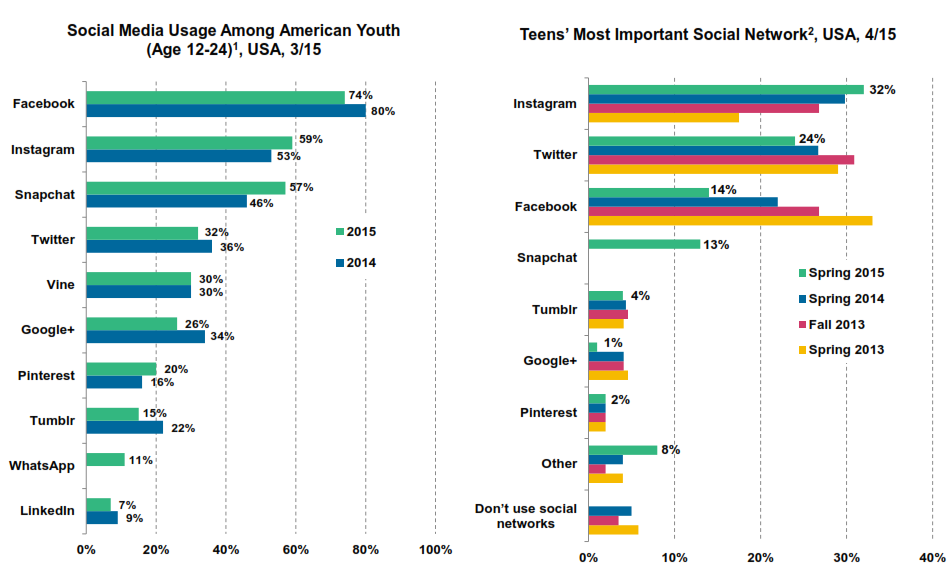
Two observations of the research are that teens love their smartphones and mobile advertising has room to grow. Photo credit: Pabak Sakar
Internet engagement continues to rise, even though Internet use and smartphone subscription growth are slowing. Certain social media networks are expanding robustly, and mobile advertising has plenty of room to grow as networks strive to improve ad formats and introduce mobile-oriented innovations.
Those are just some of the insights from the 2015 Internet Trends report from Internet guru Mary Meeker of the venture capital firm Kleiner Perkins Caufield Byers (KPCB). These are several of the key data points from the 197-slide report that marketers should note.
The mobile ad discrepancy. Almost a quarter of media (24 percent) is consumed on mobile devices, yet only 8 percent of advertising is allotted to mobile. That represents a $25 billion opportunity. Only 4 percent of media is consumed through print publications, but 18 percent of ad spending goes to print. The take-away: Marketers may find a payoff in boosting mobile ad spending and cutting print ads.
Facebook video has exploded. Facebook video views reached four billion a day, quadrupling in six months. More than half of Facebooks daily active users watch at least one video a day. Shares prompted over half the views. The take-away: B2C brands should focus on optimizing videos for Facebook.
Pinterest — not just for men anymore. The number of pins including cars and motorcycles grew 118 percent from the previous year. Pins in men’s fashion increased 96 percent. Overall, Pinterest surpassed 50 billion pinned images, a 75 percent increase in a year. The take-away: Pinterest deserves attention from brands with visually appealing products, even if they target men.
Instagram and Snap continue to grow. Instagram use by those aged 12 to 24 increased 6 percent since last year, with 59 percent saying they use the app. Snapchat use increased 11 percent in the age group, and 57 percent use the app. Meanwhile, their use of Facebook and Twitter is sliding. Still, 24 percent of teens consider Twitter their “most important social network,” second only to Instagram (32 percent). The take-away: Youth-oriented brands would be well-advised to consider marketing on Instagram and Snapchat, but not at the expense of older social media networks.
Desktop lives on. Desktop and laptop Internet access has stabilized at an average 2.4 hours a day per adult user, 42 percent of the total. But people are spending more time online overall, 5.6 hours a day compared to 2. 7 hours in 2008 due to the rise of smartphones. The take-away: Depending on your audience, don’t ignore desktop/laptop users to gain mobile customers.
View the world vertically. Because of the prevalence of smartphones, viewing photos, graphics and videos in a vertical format (as opposed to the traditional horizontal viewing aspect ratio) has increased from five percent of time spent on screens five years ago to 29 percent. The trend to vertical viewing can be challenging for marketers attuned to traditional horizontal screens. Transitioning successfully to vertical can reap dividends. Full-screen vertical video ads on Snapchat have completion rates nine times higher than horizontal ads. The good news is that new tools, such as Google Local Inventory Ads, Pinterest Cinematic Pins and Facebook Carousel Ads, cater to the mobile audience.
Bottom Line: The comprehensive 2015 Internet Trends report from Mary Meeker, sometimes referred to as the Queen of the Internet, offers a wealth of data and insights for marketers. We’ve distilled the extensive report into key nuggets that highlight major trends — some expected and some surprising.
William J. Comcowich founded and served as CEO of CyberAlert LLC, the predecessor of Glean.info. He is currently serving as Interim CEO and member of the Board of Directors. Glean.info provides customized media monitoring, media measurement and analytics solutions across all types of traditional and social media.






Wow – that was impressive and encouraging. Thanks for sharing your authoritative opinion, practical hints and a gold mine of FREE resources. I will definitely follow your updates.